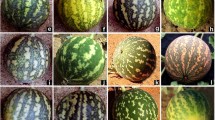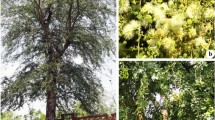Abstract
Among monocots forming the grass family (Poaceae), Cymbopogon is one of the most important aromatic essential oil yielding genera. Genetic characterization is very important for proper utilization and improvement of the oil grasses. An improved random amplified polymorphic DNA (RAPD) analysis where touchdown polymerase chain reaction with prolonged RAMP time has been used to characterize the genetic variation in ten Indian elite cultivars of Cymbopogon aromatic grasses of essential oil trade types of Citronella, Palmarosa and Lemongrass. The total of 203 amplification products was scored using 23 RAPD primers, exhibiting an overall 92.61% polymorphism. Polymorphic information content (PIC), effective multiplex ratio (EMR), marker index (MI) and resolving power (RP) averaged 0.374, 7.69, 2.92 and 5.15 per primer, respectively, showing the high efficiency and reliability of the markers used. Also, RAPDs of diagnostic and curatorial importance were discerned as ‘stand alone’ molecular descriptors for cultivar and species (biotype) identification. The order of the average value of Jaccard’s coefficient of similarity was found to be C. winterianus (0.890) > C. flexuosus (0.657) > C. martinii (0.425). The present study confirms the significance of the improved RAPD method in genetic characterization of Cymbopogon sp. and can be employed for efficient identification, conservation and utilization of germplasm resources for plant improvement through conventional as well as molecular breeding approaches.






Similar content being viewed by others
References
Adhikari S, Bandopadhyay TK, Ghosh PD (2013) Assessment of genetic diversity in certain Indian elite clones of Cymbopogon species through RAPD analysis. Indian J Biotechnol 12:109–114
Adhikari S, Saha S, Bandyopadhyay TK, Ghosh P (2015) Efficiency of ISSR marker for characterization of Cymbopogon germplasms and their suitability in molecular barcoding. Plant Syst Evol 301:439–450
Anderson JA, Churchill GA, Autrique JE, Tanksley SD, Sorrels ME (1993) Optimizing parental selection for genetic linkage maps. Genome 36:181–186
Arens P, Odinot P, Van Heusden AW, Lindhout P, Vosman B (1995) GATA and GACA repeats are not evenly distributed throughout the tomato genome. Genome 38:84–90
Bhattacharya S, Bandopadhyay TK, Ghosh PD (2010) Efficiency of RAPD and ISSR markers in assessment of molecular diversity in elite germplasms of Cymbopogon winterianus across West Bengal, India. Emir J Food Agric 22:13–24
Dalamu Behera TK, Gaikwad AB, Saxena S, Bharadwaj C, Munshi AD (2012) Morphological and molecular analyses define the genetic diversity of Asian bitter gourd (Momordica charantia L.). Aust J Crop Sci 6:261–267
Don RH, Cox PT, Wainwright BJ, Baker K, Mattick JS (1991) ‘Touchdown’ PCR to circumvent spurious priming during gene amplification. Nucleic Acids Res 19:4008
Ellinghaus P, Badehorn D, Blümer R, Becker K, Seedorf U (1999) Increased efficiency of arbitrarily primed PCR by prolonged ramp times. Biotechniques 26:626–630
Fu J, Yang L, Khan MA, Mei Z (2013) Genetic characterization and authentication of Lonicera japonica Thunb. by using improved RAPD analysis. Mol Biol Rep 40:5993–5999
Ganjewala D (2008) RAPD characterization of three selected cultivars OD-19, GRL-1 and Krishna of East Indian Lemongrass (Cymbopogon flexuosus Nees ex Steud) wats. Am Eurasian J Bot 1:53–57
Ghosh P, Chattopadhyay SK, Adhikari S, Saha S, Mondal S, Kader A, Dey ST, Bandyopadhyay TK, Sengupta C (2013) A high throughput DNA extraction method from chemotypically heterogeneous plant species. Protocol Exchange. doi:10.1038/protex.2013.018
Grativol C, da Fonseca Lira-Medeiros C, Hemerly AS, Ferreira PCG (2011) High efficiency and reliability of inter-simple sequence repeats (ISSR) markers for evaluation of genetic diversity in Brazilian cultivated Jatropha curcas L. accessions. Mol Biol Rep 38:4245–4256
Jaccard P (1908) Nouvelles recherches sur la distribution florale. Bulletin de la Société Vaudoise des Sciences Naturelles 44:223–270
Jagadishchandra KS (1975) Recent studies on Cymbopogon Spreng. (aromatic grasses) with special reference to Indian Taxa: cultivation and ecology: a review. J Plant Crops 3:1–5
Khanuja SPS, Shasany AK, Pawar A, Lal RK, Darokar MP, Naqvi AA, Rajkumar S, Sundaresan V, Lal N, Kumar S (2005) Essential oil constituents and RAPD markers to establish species relationship in Cymbopogon Spreng. (Poaceae). Biochem Syst Ecol 33:171–186
Kumar J, Verma V, Goyal A, Shahi AK, Sparoo R, Sangwan RS, Qazi GN (2009) Genetic diversity analysis in Cymbopogon species using DNA markers. Plant Omics J 2:20–29
Lal RK, Misra HO, Sharma JR, Singh N, Shasany AK, Naqvi AA, Bahl JR, Prasad A, Khanuja SPS (2004) Citral rich high yielding Lemongrass plant ‘Nima’ of Cymbopogon flexuosus. US Patent 20040194175
Mei ZQ, Fu SY, Yu HQ, Yang LQ, Duan CG, Liu XY, Gong S, Fu JJ (2014) Genetic characterization and authentication of Dimocarpus longan Lour. using an improved RAPD technique. Genet Mol Res 13:1447–1455
Mir JI, Ahmed N, Rashid R, Wani SH, Sheikh MA, Mir H, Parveen I, Shah S (2012) Genetic diversity analysis in apricot (Prunus armeniaca L.) germplasms using RAPD markers. Indian J Biotechnol 11:187–190
Prevost A, Wilkinson MJ (1999) A new system for comparing PCR primers applied to ISSR fingerprinting of potato cultivars. Theor Appl Genet 98:107–112
Rohlf FJ (1993) NTSYS-pc (numerical taxonomy and multivariate analysis system), version 2.11. Exeter Software, Setauket
Roldan-Ruiz I, Dendauw J, Vanbockstaele E, Depicker A, De Loose M (2000) AFLP markers reveal high polymorphic rates in ryegrasses (Lolium spp.). Mol Breed 6:125–134
Sangwan RS, Sangwan NS (2000) Metabolic analysis of oilchemotypic diversity in Cymbopogons. In: Kumar S, Dwivedi S, Kukreja AK, Sharma JR, Bagchi GD (eds) Cymbopogons: the aromatic grass monograph. CIMAP, Lucknow, pp 223–247
Sangwan NS, Yadav U, Sangwan RS (2001) Molecular analysis of genetic diversity in elite Indian cultivars of essential oil trade types of aromatic grasses (Cymbopogon species). Plant Cell Rep 20:437–444
Sangwan NS, Yadav U, Sangwan RS (2003) Genetic diversity among elite varieties of the aromatic grasses, Cymbopogon martinii. Euphytica 130:117–130
Sharma JR, Lal RK, Mishra HO, Naqvi AA (1987) A genetically improved clone-IMAP/LS.48 var. Pragati of L.G. (C. flexuosus) developed. J Med Arom Plant Sci 9:17–19
Sharma JR, Lal RK, Misra HO (1997) Tripta: a superior variety of palmarosa. Pafai J 19:37–44
Sharma SN, Shahi AK, Srivastava TN (2000) Taxonomic relationship of Cymbopogon species based on volatile leaf oil chemical constituents. J Econ Tax Bot 24:115–122
Stapf O (1906) The oil grass of India and Ceylon. Kew Bull 8:297–463
Thimmappaiah WG, Santhosh DS, Melwyn GS (2009) Assessment of genetic diversity in cashew germplasm using RAPD and ISSR markers. Sci Hort 120:411–417
Varshney RK, Chabane K, Hendre PS, Aggarwal RK, Graner A (2007) Comparative assessment of EST- SSR, EST-SNP and AFLP markers for evaluation of genetic diversity and conservation of genetic resources using wild, cultivated and elite barleys. Plant Sci 173:638–649
Wang G, Whittam TS, Berg CM, Berg DE (1993) RAPD (arbitrary primer) PCR is more sensitive than multilocus enzyme electrophoresis for distinguishing related bacterial strains. Nucleic Acids Res 21:5930–5933
Acknowledgements
The authors thankfully acknowledge CIMAP, Lucknow; NBPGR, Cuttack and Prof. M.L. Ghosh, Department of Botany, B. N. Mahavidyalaya for providing the cultivars. The authors thankfully acknowledge University Grants Commission (UGC) for financial support for this research project (F.6-6/2014-15/EMERITUS-2014-15-GEN-4021/SA-II). The authors would also like to thank Department of Science & Technology (DST) for providing central grant (DST-PURSE and DST-FIST) and University of Kalyani for central instrumentation facilities for this research project.
Author information
Authors and Affiliations
Corresponding author
Ethics declarations
Conflict of interest
The authors declare that they have no competing interest.
Rights and permissions
About this article
Cite this article
Adhikari, S., Saha, S., Biswas, A. et al. Randomly primed improved PCR approach for genetic characterization and identification of Cymbopogon germplasms. Rend. Fis. Acc. Lincei 28, 379–392 (2017). https://doi.org/10.1007/s12210-017-0605-3
Received:
Accepted:
Published:
Issue Date:
DOI: https://doi.org/10.1007/s12210-017-0605-3




